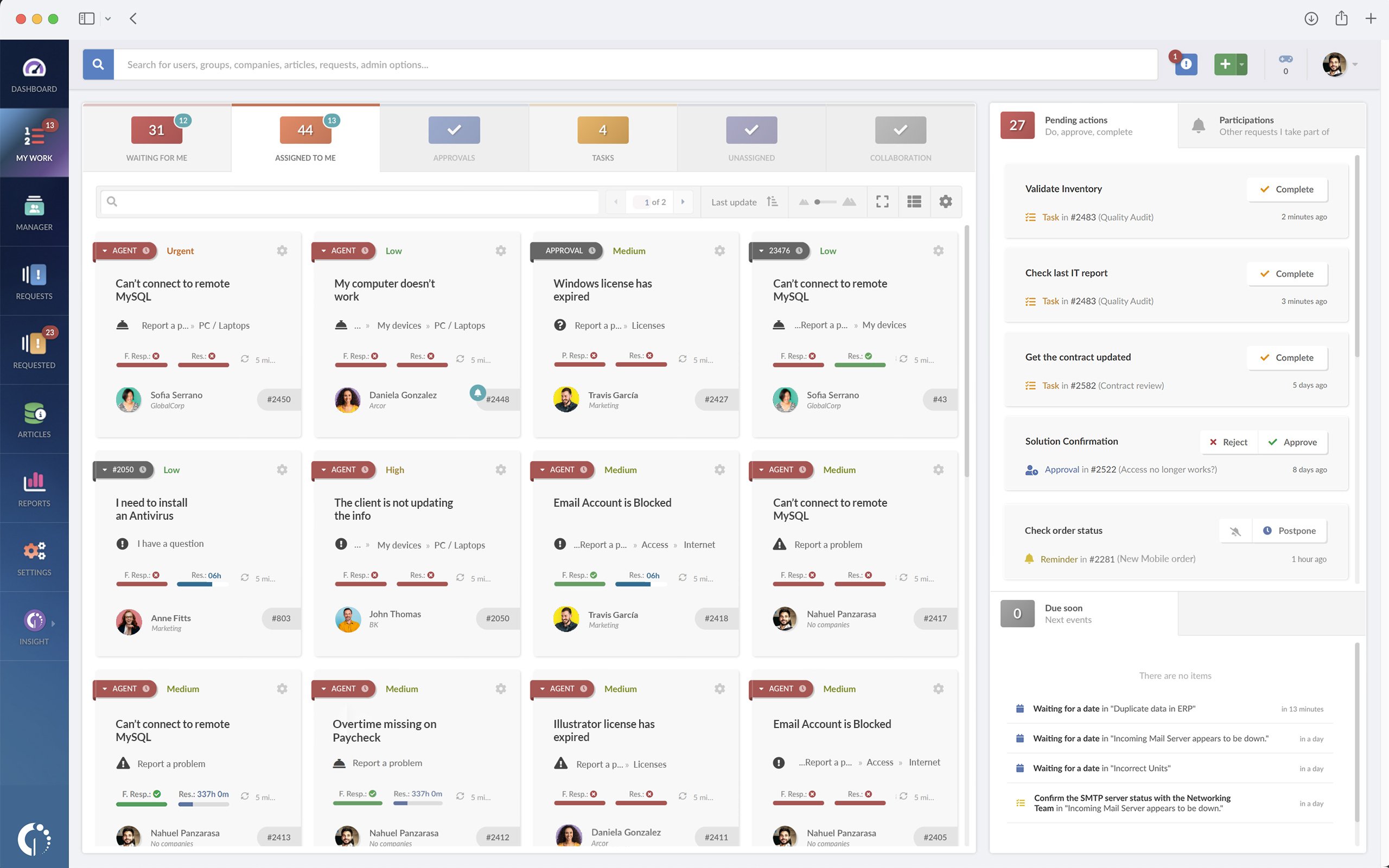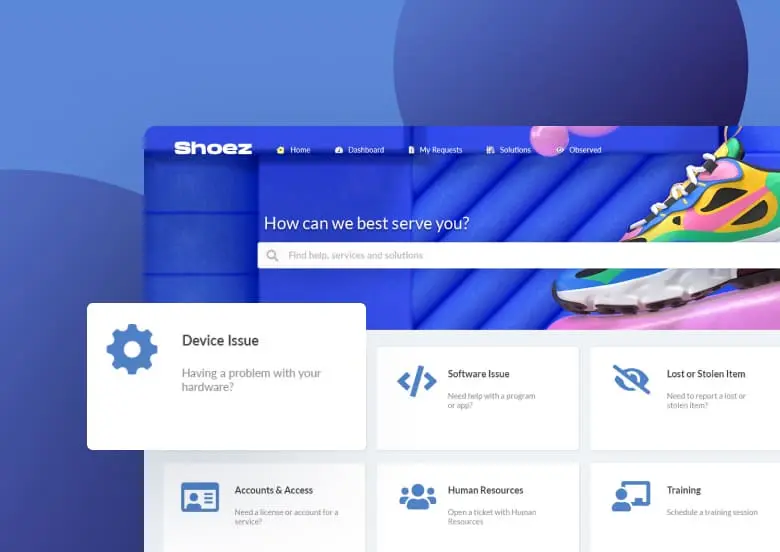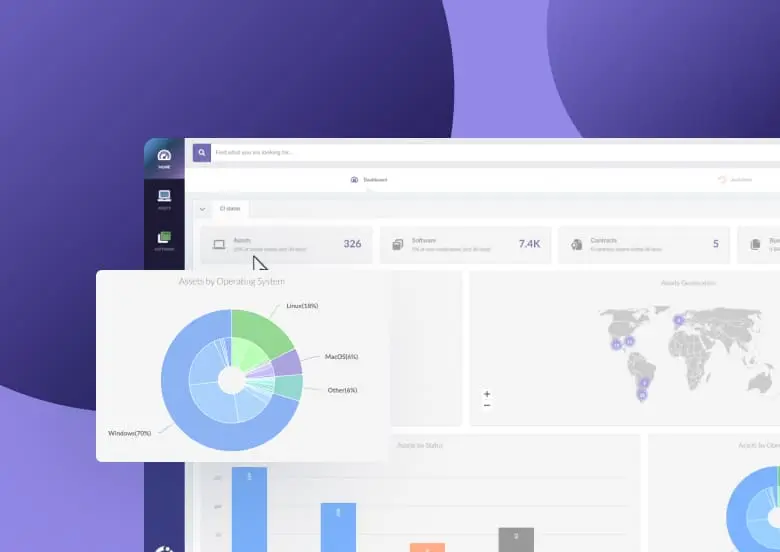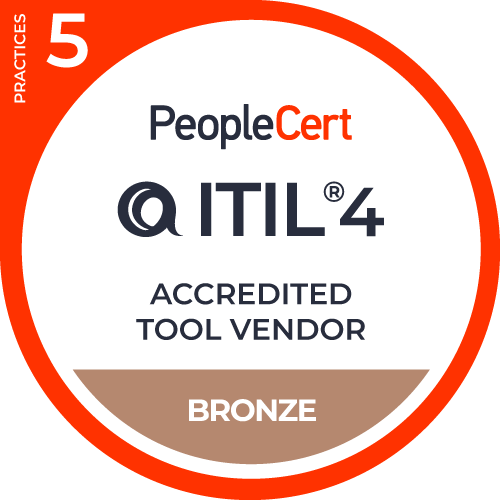Service Request Management is the practice that helps you ensure service requests are dealt with effectively, efficiently, and consistently. It improves both customer and employee experience, and makes it easier for your service desk and IT support teams to deliver services to end-users.
The most operative way to implement this practice is by adopting an ITSM solution that works as a central point of contact for users to direct their service requests and enables you to streamline key processes.
So, keep reading to learn all about Service Request Management, its full scope of benefits for your organization, best practices, and how to put it into action right away with InvGate Service Management.
Let's go!
What is Service Request Management?
Service Request Management is included in the Service Management practice area of the ITIL 4 service value system. The purpose of this practice is defined by the framework as “to support the agreed quality of a service by handling all pre-defined, user-initiated service requests in an effective and user-friendly manner."
Basically, under the scope of ITSM, Service Request Management brings together a range of processes to coordinate the resolution of service requests in an efficient and timely manner and according to the Service Level Agreements (SLAs) set by all involved parties.
What is a service request?
A service request is a request made by a user or customer for assistance, information, new hardware or software, or access to a service provided by an organization's IT department or service provider.
The ITIL service request definition is: "a request from a user or a user's authorized representative that initiates a service action that has been agreed as a normal part of service delivery."
In the realm of ITSM, these requests are usually operated through tickets. This enables end-users to submit their petitions into the service desk and help desk agents to track and manage them until their resolution in an organized and centralized way.
Examples of service requests include:
- Access requests: Requests for access to specific systems, applications, or resources, such as user account management, password resets, or permission changes.
- Hardware requests: Requests for new hardware devices, peripherals, or equipment, such as laptops, printers, or mobile devices.
- Software installation: Requests for installing new software applications on a user's device.
- Report requests: Requests for generating or delivering reports or data analysis.
- Training requests: Requests for training sessions, workshops, or tutorials on using certain software applications or tools.
Service Request Management benefits
Done well, Service Request Management can improve user experience by acting as a shop window to IT. It can also support help desk agent’s job by providing them clear and useful guidelines to carry out their tasks.
In more detail, the benefits of Service Request Management include:
- Better organized workplace: Having a central point of contact for users to direct service requests helps make sure no petition is lost, ignored, or forgotten about.
- Improved colleague experience or CX: It ensures that colleagues and customers have an effective process for submitting and keeping track of their requests, boosting their overall experience.
- Greater process transparency: Users and IT staff can monitor the progress of requests in real time, promoting transparency and accountability in IT service delivery.
- A more consistent process: Request Management enforces user models and standard procedures for request fulfillment, reducing the potential for error and ensuring consistent service delivery.
9 steps of the Service Request Management process
The key steps in Service Request Management process typically include the following:
- Request capture and logging: The first step is when the user makes the request by contacting or submitting a ticket into the service desk. Once it has been received, it is logged into the Request Management module of the ITSM tool. This stage includes capturing essential details about the request, such as the requester's contact information, the type of request, and the appropriate priority level.
- Categorization and prioritization: Each request of service is categorized based on predefined criteria to help the service desk assign them to the correct team quickly and accurately. Requests are also prioritized to ensure that their impact and urgency is efficiently managed.
- Authorization (if appropriate): Depending on the nature of the request, authorization might be required before the request can be progressed. Examples of approval might be necessary for certain types of requests for particular equipment, secure services, or those exceeding a certain cost threshold.
- Fulfillment: The request is then assigned to the appropriate support team to be actioned.
- Communication: The service desk must manage communication with the end user throughout the request fulfillment process to keep them updated on the request status, any delays, and estimated completion times. If your tool offers a self-service portal, users can track their own tickets without the need of an agent to be available to assist them.
- Closure and feedback: Once the request has been fulfilled, it is marked as completed in the ITSM tool. The service desk will then contact the end user and ensure all is well before closing off the request.
- Continual improvement: Carrying out reviews of your request management process to ensure it continues to align with the needs of the brains by monitoring user feedback and industry best practices.
InvGate Service Management as your Service Request Management software
InvGate Service Management is a comprehensive ITSM tool designed to help you manage your service requests throughout their whole lifecycle.
Although it was originally designed for IT services, its flexibility, scalability, and intuitive UX enable you to easily adapt its features across departments and offer support at an Enterprise Service Management (ESM) level.
The following capabilities will help you successfully implement a Service Request Management strategy in your business:
- Ticket Management: The tool offers a powerful ticketing system for end-users from all departments to easily submit their requests and agents to prioritize and manage them accordingly. This works along its workflow automation features, enabling you to automatically route tickets, streamline standard tasks, and improve your overall Ticket Queue Management.
- Self-service portal and knowledge base: On InvGate Service Management, you can design your self-service portal according to your needs for customers to easily track and, when possible, solve their requests. This includes a centralized knowledge base that brings together insights and tools on how to solve common tickets, also helping to reduce your Ticket Volume.
- Reports and analytics: Constant improvement is a key element to keep Service Request Management aligned with your business goals. You can easily track your chosen help desk metrics on InvGate Service Management through its customizable dashboards and reports and share them with your team members to find areas for improvement.
This is just a brief review of what InvGate Service Management can do for your Service Management practices. If you want to further explore the tools possibilities, you can book a quick call with our experts (no fine print, we swear).
10 best practices for ITIL Service Request Management
Service Request Management is a practice that can quickly impact and improve your IT service delivery. Here are some best practices to make your process even better and help you constantly improve:
- Give your customers a choice of request channels: Provide multiple channels (self-service portal, phone, email, web chat, for example) so that users can submit requests in the way they find most convenient. Ensure these channels are well-publicized and easily accessible.
- Build a consistent request capture form: Mirror what is in place for the Incident Management practice so that service desk request forms have a consistent look and feel. This will help ensure user adoption.
- Lean into your service catalog: Maintain a complete and updated service catalog that outlines the services available, their descriptions, and how to access them. Having a service catalog means your users are more likely to engage with IT and the service desk as they can see what is supported and where to go for information and help.
- Make your service catalog actionable: You could make your service catalog actionable by allowing users to log service requests by clicking on a service.
- Encourage self-service: Allow end users to log their own requests in your tool and implement a tracking system that allows users and support staff to monitor the status of requests in real-time.
- Introduce a knowledge base: Build knowledge base articles to guide users through recurrent requests. Review the most frequently occurring questions and create FAQ content accordingly. Common user queries could include how to use MFA, what to do in case of a forgotten password, or how to deal with potential phishing emails.
- Automate routine processes: Automate repetitive tasks like request categorization and assignment using workflow automation and Incident Management tools. This reduces manual errors and accelerates response times.
- Put SLAs in place for managing IT service requests: It’s common that organizations are very focused on meeting their SLAs for Incident Management and they forget about doing the same thing for requests. Establish clear SLAs for all the different types of requests and ensure the team consistently meets them and proactively communicates any potential delays.
- Use gamification: Leverage gamification to build fun into your request management process and at the same time encourage agents to level up their game through rewards and incentives.
Wrapping up
Service Request Management is the practice that ensures all service requests are effectively managed . This includes all routine requests for assistance, information, new hardware, software, or system access that go through an organization on a daily basis.
The best way to implement this practice is through a service desk that serves as a single point of contact to submit and track requests throughout their lifecycle. Key stages in this resolution process include logging, categorization, prioritization, approval, fulfillment, and closure.
If you’re ready to streamline your Service Request Management across your organization, you can access InvGate Service Management’s 30 day free trial and see for yourself its capabilities in action!
Frequently Asked Questions
What are the Service Request Management activities?
The key activities are request logging, categorization, approval, fulfillment, and closure.
What is the purpose of the Service Request Management practice?
Request Management ensures that service requests are managed effectively and that nothing is lost, ignored, or forgotten about.
What are the types of service requests?
Typical requests include requests for hardware, software, and information / FAQs.
What is the difference between an incident request and a service request?
They are both dealt with by the service desk. However, incidents have to do with fault resolution; if something is broken or not performing as it should, the incident management process is in place to ensure that it is resolved as quickly as possible with as little adverse impact on the business as possible. A service request is a request for hardware, software, or other small item.
Which roles can create and manage service requests?
Typically, the service desk would create and manage service requests. End users can also log on to them if you offer a self-service channel.















